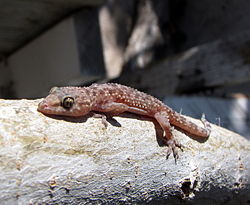| Gecko | |
|---|---|
 | |
| Gold dust day gecko | |
| Scientific classification | |
| Kingdom: | Animalia |
| Phylum: | Chordata |
| Class: | Reptilia |
| Order: | Squamata |
| Clade: | Gekkonomorpha |
| Suborder: | Gekkota Cuvier, 1817 |
| Subgroups | |
Geckos are small, mostly carnivorous lizards that have a wide distribution, found on every continent except Antarctica. Belonging to the suborder Gekkota, geckos are found in warm climates. They range from 1.6 to 67 centimetres (0.6 to 26.4 inches ).
Contents
- Etymology
- Common traits
- Shedding or molting
- Adhesion ability
- Skin
- Teeth
- Taxonomy and classification
- Evolutionary history
- Species
- Reproduction
- Mythology
- References
- Further reading
- External links
Geckos are unique among lizards for their vocalisations, which differ from species to species. Most geckos in the family Gekkonidae use chirping or clicking sounds in their social interactions. Tokay geckos (Gekko gecko) are known for their loud mating calls, and some other species are capable of making hissing noises when alarmed or threatened. They are the most species-rich group of lizards, with about 1,500 different species worldwide. [2]
All geckos, except species in the family Eublepharidae, lack eyelids; instead, the outer surface of the eyeball has a transparent membrane, the brille. They have a fixed lens within each iris that enlarges in darkness to let in more light. Since they cannot blink, species without eyelids generally lick their own brilles when they need to clear them of dust and dirt, in order to keep them clean and moist. [3]
Unlike most lizards, geckos are usually nocturnal [4] and have excellent night vision; their colour vision in low light is 350 times more sensitive than human eyes. [5] The nocturnal geckos evolved from diurnal species, which had lost the rod cells from their eyes. The gecko eye, therefore, modified its cone cells that increased in size into different types, both single and double. Three different photo-pigments have been retained, and are sensitive to ultraviolet, blue, and green. They also use a multifocal optical system that allows them to generate a sharp image for at least two different depths. [6] [7] While most gecko species are nocturnal, some species are diurnal and active during the day, which have evolved multiple times independently. [4]
Many species are well known for their specialised toe pads, which enable them to grab and climb onto smooth and vertical surfaces, and even cross indoor ceilings with ease. Geckos are well known to people who live in warm regions of the world, where several species make their home inside human habitations. These, for example the house gecko, become part of the indoor menagerie and are often welcomed, as they feed on insect pests including moths and mosquitoes. Like most lizards, geckos can defensively shed their tail; the predator may attack the wriggling tail, allowing the gecko to escape. [8]
The largest species, Gigarcanum delcourti , is only known from a single, stuffed specimen probably collected in the 19th century found in the basement of the Natural History Museum of Marseille in Marseille, France. This gecko was 600 millimetres (24 inches ) long, and was likely endemic to New Caledonia, where it lived in native forests. [9] The smallest gecko, the Jaragua sphaero, is a mere 16 millimetres (0.63 inches) long and was discovered in 2001 on a small island off the coast of Hispaniola. [10]




